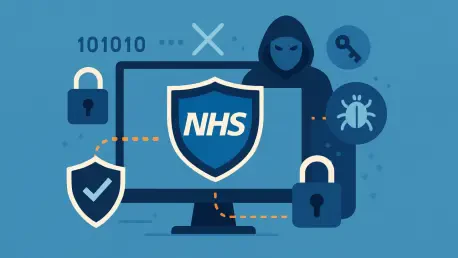The cybersecurity landscape for healthcare organizations, particularly National Health Service (NHS) Professionals, has come under scrutiny due to a significant breach that occurred in May 2024. NHS Professionals, a key provider of temporary staff to NHS trusts across England, experienced a major cybersecurity breach involving the theft of its Active Directory database. Owned by the Department of Health and Social Care, NHSP remains integral to maintaining the functionality of healthcare services across the nation with its vast network of registered healthcare professionals and employees. Despite the severity of the breach, NHSP opted not to publicly disclose the incident, which raised concerns among cybersecurity experts about transparency and preparedness. Detailed documentation from an incident response report by Deloitte revealed the intricate methods used by attackers, highlighting both immediate challenges and long-term implications for NHSP’s cybersecurity infrastructure.
Overview of Cyberattack Details
Infiltrating NHSP’s systems, cybercriminals managed to steal critical elements like the Active Directory database, essentially giving them access to sensitive information and exposing vulnerabilities. Insiders provided The Register with information detailing the attack’s progression, which exploited a compromised Citrix account known as “LMS.Support2” to gain entry into the network. What followed was a concerning escalation of privileges, with attackers securing domain admin-level access, allowing them unprecedented control over NHSP’s network systems. Despite the assortment of tools manipulated by the attackers, including Remote Desktop Protocol, SMB share access, and Windows Remote Management, the precise method through which escalation occurred remains elusive, thereby complicating NHSP’s response strategy further. The failure to acknowledge or address these flaws promptly painted a critical picture of NHSP’s approach to risk management and crisis communication.
Examination of NHSP’s Defensive Actions
In response to the security breach, NHSP initiated a series of mitigation efforts, although the initial absence of key security measures was troubling. Before the breach, NHSP was missing vital components such as multi-factor authentication for domain accounts and comprehensive endpoint detection and response solutions, rendering it susceptible to sophisticated cyber threats. During the attack, NHSP endeavored to retrofit its security framework by enabling multi-factor authentication and deploying Microsoft Defender for Endpoint. However, by June 2024, complete deployment was yet to be achieved, reflecting challenges in safeguarding its digital perimeter adequately. Actions undertaken included resetting authentication certificates and rotating passwords for all user accounts, aiming to reinforce NHSP’s defenses against further intrusions. Moreover, NHSP adjusted Citrix deployments by restricting non-essential feature access, hoping to prevent future exploitation similar to what transpired in the recent attack on its systems.
Recovery and Security Audit Development
Even as Deloitte’s report indicated ongoing recovery efforts, NHSP found itself struggling to complete all steps essential for reinforcing long-term security measures. While NHSP made strides in key areas, like cross-organization deployment of multi-factor authentication and refined service account permissions, the response remained fragmented. Notably absent were critical preventive actions such as blocking downloads of unrecognized programs, a lapse that contributed to pre-ransomware activities detected in system logs. Additionally, inadequate retention periods for Windows Event Logs hindered investigative actions, forcing NHSP to extend logs’ retention to allow more comprehensive analysis. Though by June 2025, NHSP exhibited signs of improvement, promptly addressing these issues continued to challenge its cybersecurity framework. Insight from industry experts suggests its progress might be hampered by misaligned priorities at executive levels, thus exacerbating the time required to fully restore robust security within its operations.
Implications and Lessons for the Healthcare Sector
The breach transcends NHSP’s technical and procedural failures, exposing deeper issues that resonate throughout NHS’s security culture. Despite claims of surpassing national standards, this incident revealed glaring deficiencies embedded in its cybersecurity practices, necessitating urgent improvements. While NHSP conducted self-assessments using the NHS’s Data Security and Protection Toolkit, the breach starkly illustrates the discrepancies between perceived and actual security postures within healthcare operations. The consequences of cyber threats targeting healthcare systems have grown over time, demanding proactive strategies to safeguard sensitive data and ensuring operational continuity in essential services. This evolving landscape calls for renewed focus on the adaptability and resilience of defenses across the NHS ecosystem. The pursuit of robust cybersecurity hinges on accountability, compliance verification, and continuous improvement to anticipate and counteract potential threats effectively.
Moving Forward: Insights and Recommendations
After experiencing a significant security breach, NHSP took action to mitigate the impact, though the initial lack of certain critical security protocols raised concerns. Prior to the breach, NHSP’s security setup lacked essential components like multi-factor authentication for domain accounts and robust endpoint detection and response tools, making it vulnerable to complex cyberattacks. In the midst of the attack, NHSP attempted to upgrade its security measures by implementing multi-factor authentication and rolling out Microsoft Defender for Endpoint. Nevertheless, by June 2024, the updates were not fully deployed, highlighting ongoing difficulties in effectively protecting its digital infrastructure. To strengthen its defenses, NHSP reset authentication certificates and rotated passwords for all user accounts, aiming to guard against further breaches. Additionally, NHSP modified its Citrix deployments, limiting access to non-critical features, with the goal of averting future attacks similar to the recent incident that compromised its systems.









